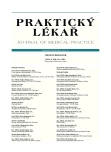Atypical course of pneumonia with extrapulmonary complications due to Mycoplasma pneumoniae infection
Authors:
R. Brnka; I. Jurkovičová; doc. MUDr. Emőke Šteňová, PhD.
Authors‘ workplace:
Prednostka: doc. MUDr. Soňa Kiňová, PhD.
; I. Interná klinika Lekárskej fakulty Univerzity Komenského a Univerzitnej nemocnice Bratislava
Published in:
Prakt. Lék. 2012; 92(5): 294-296
Category:
Case Report
Overview
Mycoplasma pneumoniae (M. pneumoniae) is an extracellular pathogen that penetrates the ciliated layer of the respiratory mucus and firmly adheres to the surface of the epithelial cells. It differs from other bacteria by not producing peptidoglycan and thereby not forming a firm cell wall. This close contact of cells and mycoplasmas allows for membrane fusion and the exchange of antigens, which explains many extrapulmonary complications from autoimmune reactions (Such as myocarditis, pericarditis, encephalitis, peripheral neuropathy, haemolytic anaemia, Stevens-Johnson syndrome, mucositis, epidermal necrolysis, myelitis, coagulopathy, erythema multiforme, macular rash, erythema nodosum, hepatocellular jaundice, acute pancreatitis, acute glomerulonephritis, renal failure, cholestatic hepatitis, even coma and others). M. pneumoniae is a common cause of upper respiratory tract infections, but it can take the course of atypical bronchopneumonia. Diagnosis can be confirmed with high probability by serological examination of antibody titre of immunoglobulin M (IgM), where an IgM antibody titre of 1:32 is considered highly significant. However, positivity is manifested in only 50–70 % of patients 7–10 days after the outbreak of disease. A negative result, however, does not exclude a possible ongoing infection.
Key words:
Mycoplasma pneumoniae, extrapulmonary symptoms, atypical pneumonia
Sources
1. Atkinson TP, Balish MF, Waites KB. Epidemiology, clinical manifestations, pathogenesis and laboratory detection of Mycoplasma pneumoniae infections. FEMS Microbiol Rev 2008; 32: 956–973.
2. Cimolai N, Wensley D, Thomas ET. Mycoplasma pneumoniae as a cofactor in severe respiratory infections. Clin Infect Dis 1995; 21: 1182–1185.
3. Daxboeck F. Mycoplasma pneumoniae CNS infections. Curr Opin Neurol 2006; 19: 374–378.
4. Ferwerda A, Moll HA, de Groot R. Respiratory tract infections by Mycoplasma pneumoniae in children: A review of diagnostic and therapeutic measures. Eur J Pediatr 2001; 160: 483–491.
5. Foy HM, Cooney MK, McMahan R, Grayston JT. Viral and mycoplasmal pneumonia in a prepaid medical group during an eight year period. Am J Epidemiol 1973; 97: 93–102.
6. Gavranich JB, Chang AB. Antibodies for community acquired lower respiratory tract infections secondary to M.pneumoniae in children. Cochrane Database Syst Rev 2005; 3: CD004875
7. Guleria R, Nisar N, Chawla TC, Biswas NR. Mycoplasma pneumoniae and central nervous system complications: A review. J Lab Clin Med 2005; 146: 55–63.
8. Chan ED, Welsh CH. Fulminant Mycoplasma pneumoniae pneumonia. Western J Med 1995; 162: 133–142.
9. Jayantha UK. Mycoplasma pneumoniae infection in Sri Lanka. Sri Lanka J Child Health 2007; 36: 43-47.
10. Kashyap S, Sarkar M. Mycoplasma pneumonia: Clinical features and management. Lung India 2010; 27: 75–85.
11. Kountouras D, Deutsch M, Emmanuel T, et al. Fulminant Mycoplasma pneumoniae infection with multi-organ involvement: A case report. Eur J Intern Med 2003; 14: 329–331.
12. Leonardi S, Pavone P, Rotolo N, La Rosa M. Stroke in two children with Mycoplasma pneumoniae infection: A casual or causal relationship? Pediatr Infect Dis J 2005; 24: 843–845.
13. Linchevski I, Klmenet E, Nir-Paz R. Mycoplasma pneumoniae vaccine protective efficacy and adverse reactions: Systemic review and meta-analysis. Vaccine 2009; 27: 2437–2446.
14. Marston BJ, Plouffe JF, File TM Jr, et al. Incidence of community acquired pneumonia requiring hospitalization: Results of a population based active surveillance study in Ohio: The community based pneumonia incidence study group. Arch Intern Med 1997; 157: 1709–1718.
15. Puljiz I, Kuzman I, Dakovic-Rode O, et al. Chlamydia pneumonia and Mycoplasma pneumoniae pneumonia: Comparison of clinical, epidemiological characteristics and laboratory profilesm. Epidemiol Infect 2006; 134: 548–555.
16. Razin S, Yogev D, Naot Y. Molecular biology and pathogenicity of mycoplasmas. Microbiol Rev 1998; 63: 1094–1156.
17. Sanchez-Vargas FM, Gomez-Duarte OG. Review Mycoplasma pneumoniae: An emerging extra-pulmonary pathogen. Clin Microbiol Infect 2008; 14: 105–115.
18. Schwarzmeier Josef D. A potentially fatal complication of Mycoplasma pneumoniae infection: The hemophagocytic syndrome. Respiration 2002; 69: 14–15.
19. Taylor-Robinson D, Bebear C. Antibiotic susceptibilities of mycoplasmas and treatment of mycoplasmal infections. J Antimicrob Chemother 1997; 40: 622–630.
20. Vanfleteren I, Van Gysel D, De Brandt C. Stevens-Johnson syndrome: A diagnostic challenge in the absence of skin lesions. Pediatr Dermatol 2003; 20: 52–56.
21. Vervloet LA, Marguet C, Camargos PA. Infection by Mycoplasma pneumoniae and its importance as an etiological agent in childhood community acquired pneumonias. Braz J Infect Dis 2007; 11: 507–514.
22. Waites KB, Talkington DF. Mycoplasma pneumoniae and its role as a human pathogen. Clin Microbiol Rev 2004; 17: 697–728.
23. Zou CC. Multiple hypoechoic lesions in spleen and Mycoplasma pneumoniae infection. Indian Paediatr 2005; 42: 379–382.
Labels
General practitioner for children and adolescents General practitioner for adultsArticle was published in
General Practitioner

2012 Issue 5
- Memantine Eases Daily Life for Patients and Caregivers
- Metamizole vs. Tramadol in Postoperative Analgesia
- Metamizole at a Glance and in Practice – Effective Non-Opioid Analgesic for All Ages
- Memantine in Dementia Therapy – Current Findings and Possible Future Applications
- What Effect Can Be Expected from Limosilactobacillus reuteri in Mucositis and Peri-Implantitis?
Most read in this issue
- REM behavior disorder – a neglected diagnosis
- Eosinophilic pneumonia and systemic vasculitis
- Atypical course of pneumonia with extrapulmonary complications due to Mycoplasma pneumoniae infection
- Significant aortic stenosis in routine clinical practice
